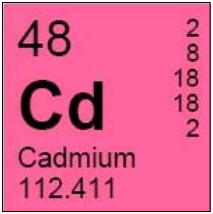Cadmium
View/Download PDF Version
Cadmium
- Cadmium is a blue-white metallic element. Cadmium is used in many types of solders, batteries, television sets, pigments, ceramics, photography, insecticides, and used for electroplating. Sources of contamination in drinking water include corrosion of galvanized pipes, erosion of natural deposits, discharge from metal refineries, and runoff from waste batteries and paints.
- The US Environmental Protection Agency (USEPA) has set a drinking water standard of 0.005 mg/L for cadmium in public drinking water supplies. These regulations do not apply to private water supplies but the health implications are the same for private well owners.
- Severe toxic symptoms occur following ingestion of 10 to 300 mg of cadmium. It would take over 50 gallons of cadmium contaminated water at 10 times the USEPA standard to get a 10 mg dose. The more likely type of health effect from cadmium comes from low dosages over a long period of time or “chronic” effects. Kidney damage is the primary health effect from cadmium.
- Treatment of water for cadmium can be accomplished with reverse osmosis and distillation systems.
Additional Resources
Click on the links below to be directed to more resources.
NSF International Contaminant Guide (Listed Under “Drinking Water”)
US EPA Drinking Water Contaminants
US EPA National Primary Drinking Water Regulations
Water Quality Interpretation Tool
Handbook of Drinking Water Quality; John DeZuane; 1997
